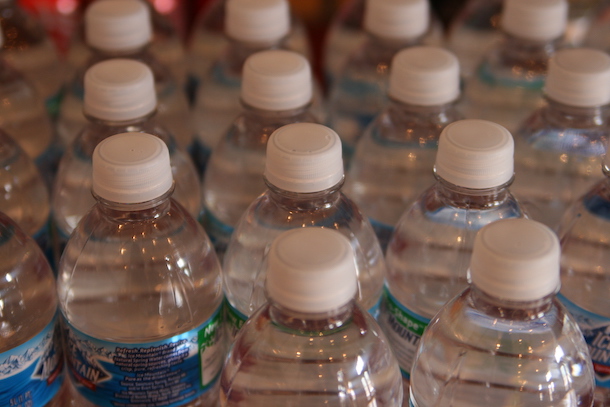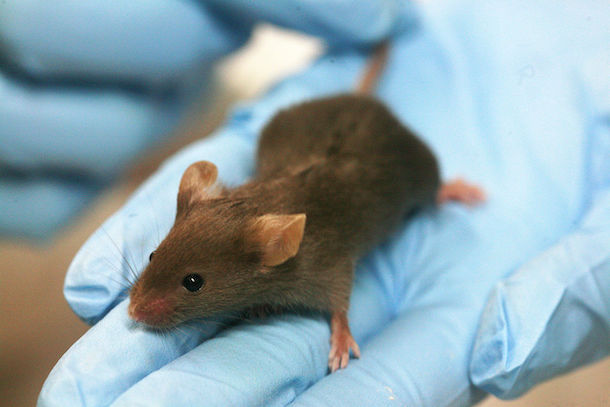Food and Drug Admin. Disputes BPA Health Risks
Air Date: Week of February 28, 2020

Bisphenol-A is an estrogen mimicker, and frequently found in plastics such as disposable water bottles, metal food cans, and even baby bottles. (Photo: Quinn Dombrowski, Flickr, CC BY-SA 2.0)
The chemical BPA, an endocrine disruptor, is widely used in food packaging. Environmental Health News published a reported series showing that the U.S. Food and Drug Administration has stacked the deck against findings from independent scientists that link BPA to harmful human health effects, ranging from birth defects to cancer. Science journalist Lynne Peeples joins Host Steve Curwood to discuss this investigation and why even BPA alternatives may also not be safe.
Transcript
CURWOOD: From PRX and the Jennifer and Ted Stanley Studios at the University of Massachusetts Boston, this is Living on Earth, I’m Steve Curwood.
Many synthetic chemicals today can pose health risks by mimicking those in our body’s endocrine systems, such as neurotransmitters, immune factors, and hormones including estrogen. More than ninety percent of us have been exposed to Bisphenol-A, or BPA, an estrogen mimic that is widely used in plastic products like food containers and even baby bottles. Environmental Health News launched a four-part investigative report called “Exposed”, which shows that the U.S. Food and Drug Administration has stacked the deck against findings from independent scientists that link BPA to harmful human health effects, ranging from birth defects to cancer. Lynne Peeples reported the series and she joins us now from Seattle. Lynne, welcome to Living on Earth!
PEEPLES: Thanks so much for having me on.
CURWOOD: Well, give us a brief synopsis of what you did in this series of stories for Environmental Health News.
PEEPLES: Sure. So, kind of the driver here is this ongoing rift between academic scientists and federal and industry scientists. For many years, academics have been doing these studies, thousands now that they've published, that have found that just small doses of endocrine disruptors such as BPA, can cause harm. Meanwhile, the FDA still claims that BPA, at the doses at which we're exposed, does not pose any real health concerns. So there's been this conflict that's been ongoing. And this great idea came along, aptly named Clarity, which stands for Consortium Linking Academic and Regulatory Insights on BPA Toxicity. So this multi-million dollar project, co-led by the FDA, was launched and it is ongoing. But over the last few years, academic scientists and the government have published their data. Looking at the same set of rats and looking in their own ways at whether or not BPA has a health effect. Historically, the government has been evaluating BPA and other endocrine disruptors, looking for more kind of obvious effects or certain things that can really be easily measured, whereas academic scientists tend to look for perhaps more subtle effects, as well as effects at lower doses than the government has traditionally looked at.
CURWOOD: People listening to us may be scratching their heads a bit because it's not intuitive that tiny dosages can be toxic, even perhaps more toxic than larger ones. How does that work?
PEEPLES: Really, the idea is if you think about hormones in the human body, our bodies have been tuned to react to the tiniest of doses of hormones. The equivalent of just one drop of water in 20 Olympic sized swimming pools is enough to send instructions that can impact our growth, our metabolism, reproduction and other functions of the body. And as we've discovered, endocrine disruptors can act at the same minuscule levels in the body. So for academic scientists, it really comes as no surprise that these chemicals act in much the same way as hormones at tiny, tiny levels. And the issue here is historical, toxicologists have evaluated these chemicals with this assumption of "the dose makes the poison". So in other words, higher doses, as we've talked about, you know, cause more harm. Because of that assumption, the way that we've generally tested the chemicals is starting to expose lab animals to extremely high doses of the chemical, and then kind of ratcheting that down to a point at which they don't see effects and then from there, making a conservative estimate to drop that to a lower level. But if there are health effects that even lower doses we totally missed that. So that's where the academic scientists have been approaching the question differently and testing at some of these much lower levels.
CURWOOD: And Lynne, remind us what BPA, what Bisphenol-A is, and where it's most often found.
PEEPLES: BPA was actually discovered back in the 1930s, by a British medical researcher who found that it could mimic the activity of estrogen. So this goes way back, it was being considered for use as a hormone replacement. Instead, it found its way into plastics. You'd find it in the protective coating of cans, in some of your reusable plastic bottles, thermal paper receipts, as well as dental sealants. It's pretty widespread out there. You wouldn't necessarily have guessed that, given the pushback over the years against BPA, as you might notice a lot of BPA-free products out there on the market. And that's also worth noting that many of these BPA-free products also contain replacement chemicals that are equally harmful, if not more so, according to some studies. There's a lot of chemicals out there, we may not even know them all. And that's also kind of a fundamental issue here because the FDA, in facing this decision about how to regulate BPA, has the potential of opening this Pandora's Box. There are all these other chemicals out there on the market, chemicals that might be coming onto the market. And if, if BPA is identified as an endocrine disrupter, there's a whole lot of others that might be in line for the same kind of conclusion.

Bisphenol-A found in many plastic containers and water bottles is known to be harmful, but the substitute Bisphenol-S could be just as bad. (Photo: MMarsolais, Flickr CC BY-NC-ND 2.0)
CURWOOD: 90% of us in the U.S. have been exposed to BPA at meaningful levels in our bodies. What are some of the health effects that research may ultimately show are linked to this exposure to BPA?
PEEPLES: A lot of it is related to our hormone systems. And when you think about it, our endocrine system drives a whole lot of functions in our body, but studies are suggesting that exposures may increase the risk of cancer, of diabetes, infertility. A really scary thought is that some of these studies are pointing to the derailment of the normal development of a child's brain. So, it's a wide range of potential effects. And scientists are continuing to publish more and more of these studies and looking at new different endpoints, some of which are a little more difficult to measure.
CURWOOD: So, the academic scientists are at odds with the Food and Drug Administration. And I guess industry scientists when it comes to testing the health effects of BPA and similar chemicals. How accurate would you say that is? And what weight to the concerns of industry put on the FDA's reaction?
PEEPLES: If you look back at the previous risk assessments that the FDA has done for BPA, those assessments really rely primarily on industry-funded studies. So industry appears to have had a loud say in how we deem BPA's safety. As one example, the FDA's 2014 risk assessment of the 36 studies that they had identified as related to neurological endpoints of BPA, the FDA chose just one to include in their risk assessment. And that study was funded by industry. And independently, there was a 2006 analysis that just looked at industry-funded studies. And they found that 11 out of 11 of them had deemed that BPA had no significant action on the human body. And then, meanwhile, there were 109 of 119 studies that had no industry funding that did find effects of BPA.
CURWOOD: So, the initial hope here was that Clarity, this consortium, would reconcile the ongoing clash between the FDA and academic scientists, but it sounds like in some respects, it's heightened the tensions here, it's heightened awareness of the conflict here. How accurate is that?
PEEPLES: I would say that's pretty accurate. The academics went into this process, seemingly mostly optimistic that this really could change the playing field and change the game. And just one thing after another seemed to go down that really led them to be pretty skeptical of how this will turn out. The final integrated report is still being pulled together. So, time will tell on that. But based on my interviews and hundreds of emails obtained via FOIA, it seemed that between the study design, the data analysis approaches, and the framing and interpretations that the FDA is made of the data thus far, that there were a lot of ways in which Clarity actually has clouded the picture of BPA.

The CLARITY-BPA program was founded as a way to resolve the differences that academic scientists and government and industry-funded scientists would conclude when they would test the effects of BPA. (Photo: Rama, Wikimedia Commons, CC BY-SA 2.0)
CURWOOD: Tell me, to what extent in your view, is there bad science involved here? Things like dirty data, and biased data interpretation?
PEEPLES: There's no one smoking gun. Looking at all the data and all the evidence that I accumulated over the course of the year, there were some definite examples of ways in which the study design, the implementation, the analysis, and the presentation of the data thus far could have potentially diminished and maybe even totally hidden some of the true effects of the chemical. Now, none of these were absolutely blatant issues with the study, but they all sort of accumulated to raise a red flag. For example, some of the academic scientists I spoke with received what they say were, you know, too few animals to really have the statistical power to detect differences between their control and test animals. There was the FDA's chosen route of exposure for the animals to BPA, which as the scientists explained to me, could actually raise hormone levels due to the stress that that route of exposure caused so that could definitely diminish any obvious differences in health effects. There is some issue of potential contamination in the study. There were also concerns about the type of rat used, which previous studies had shown were insensitive to BPA. So taking all this together, there's definitely a reason why the academics remain concerned about this Clarity study really unveiling the truth behind the safety of BPA.
CURWOOD: You said that you obtained hundreds of emails. To what extent did any of those emails suggest an effort to ignore evidence of harm?
PEEPLES: So, a lot of these emails really underscored not only a rift between the FDA scientists and academic scientists but even within the government itself. So, I had a lot of emails from the National Institutes of Health. And some comments there reflecting on the FDA and its behavior with the study really struck a chord. For example, in February of 2018. This was when the FDA had completed its portion of the Clarity study, and they released a draft report, along with a press release that declared BPA safe. And NIH scientists that were involved responded amongst themselves, saying things like that the FDA officials had drafted a quote, "a statement to reiterate their current policy stance on the safety of BPA". So, there was a lot of frustration and distrust that came through on those emails. And there was also agreement before the study that there would be no public statements made until all the data was in and until that final report was put together.

Lynne Peeples is a freelance science journalist who reported the ‘Exposed’ series for Environmental Health News. (Photo: Lynne Peeples)
CURWOOD: So, the FDA went ahead and issued its statement saying BPA is fine, folks, don't worry. When in fact, the original deal, as you understand it, nothing was to be said until everything was done.
PEEPLES: Exactly. Right.
CURWOOD: How big a deal is this for public health? I've heard some say, and perhaps this is an exaggeration, that by not paying attention to the endocrine-disrupting, the hormone-disrupting effects of chemicals, it's like we're back in the stage when we didn't wash our hands to prevent the spread of infectious disease.
PEEPLES: Yeah. I mean, when you think about just how many chemicals are out there that have this potential impact of scrambling our hormones. It does frighten those scientists that I've spoken with that have a lot of expertise in this area that knowing that just a tiny quantity could have potentially profound impacts on the body. You know, where do we go from there?
CURWOOD: Lynne Peeples is an investigative reporter with Environmental Health News. Lynne, thanks so much for taking the time with us today.
PEEPLES: Thanks so much for having me.
CURWOOD: And there's more on the story at the Living on Earth website, LOE.org.
Links
Living on Earth wants to hear from you!
Living on Earth
62 Calef Highway, Suite 212
Lee, NH 03861
Telephone: 617-287-4121
E-mail: comments@loe.org
Newsletter [Click here]
Donate to Living on Earth!
Living on Earth is an independent media program and relies entirely on contributions from listeners and institutions supporting public service. Please donate now to preserve an independent environmental voice.
NewsletterLiving on Earth offers a weekly delivery of the show's rundown to your mailbox. Sign up for our newsletter today!
 Sailors For The Sea: Be the change you want to sea.
Sailors For The Sea: Be the change you want to sea.
 The Grantham Foundation for the Protection of the Environment: Committed to protecting and improving the health of the global environment.
The Grantham Foundation for the Protection of the Environment: Committed to protecting and improving the health of the global environment.
 Contribute to Living on Earth and receive, as our gift to you, an archival print of one of Mark Seth Lender's extraordinary wildlife photographs. Follow the link to see Mark's current collection of photographs.
Contribute to Living on Earth and receive, as our gift to you, an archival print of one of Mark Seth Lender's extraordinary wildlife photographs. Follow the link to see Mark's current collection of photographs.
 Buy a signed copy of Mark Seth Lender's book Smeagull the Seagull & support Living on Earth
Buy a signed copy of Mark Seth Lender's book Smeagull the Seagull & support Living on Earth

